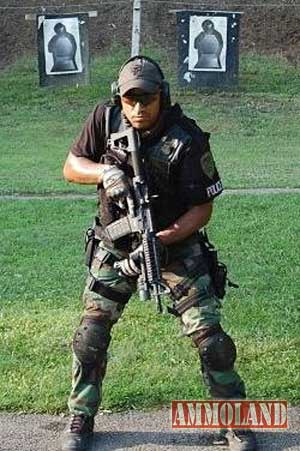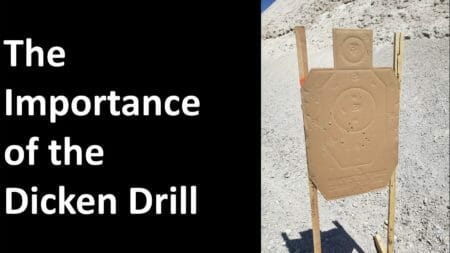The After-Action Process
By Brian C. Hartman, Chief Instructor, Progressive F.O.R.C.E. Concepts

Honeoye Falls, NY –(Ammoland.com)- Whether on the streets of Mosul or South Central Los Angeles there are several certainties: weapons fail, good guys get hurt and thugs are cowards who seldom travel alone.
Should the situation arise where you must use deadly force, breaking tunnel vision is crucial.
We have developed a principle based after-action checklist that those involved in lethal encounters can adopt to stop the action, prevent escalation and determine personal readiness to continue the fight. We like to refer to it as a checklist or process as opposed to a rigid drill since certain situations may not call for all or some of the elements.
I once had a discussion with a straight-faced SWAT officer who said that he did not need to ever train reloads or malfunctions on his long/primary weapon. He explained that if he ever used his sub-machinegun and it malfunctioned or ran dry, he would then go to his secondary/pistol. This of course would only happen if he shot someone, and concurrently their SOP required the officer who shot someone to stay with that suspect in that location. So for all intents and purposes one’s participation in the raid proper was over the moment he stopped pulling the trigger.

The logic here is so flawed it’s painful. Remain flexible to the situation and not a slave to routine… think, why am I here? If the situation is an active shooter/rapid deployment scenario we will not abide by the pedantic notion of “you catch ‘em, you clean ‘em.” Said incident may require us to rush from a dead or dying attacker in search of additional threats, expediting steps of the process to follow at best and skipping steps at worst.
1) Is the adversary down?
Unlike Hollywood, people don’t go flying backwards when shot or die instantly. Even mortal wounds often take great time to fully exhaust adversaries.
You may have to command a screaming, gurgling, begging, aggressor to lie still or worse yet, re-engage them. If firing two rounds, be ready to fire three.
Firearms qualifications often have us firing stages where we shoot two rounds to the chest immediately followed by one round to the head. In real life, if we are reacting to the first two rounds “failing to stop” then we’re doing our officers a disservice. We should have the targets briefly turn away, and then reappear to simulate a remaining threat.
2) Is my weapon still operational?
During training it often amazes us just how often students will scan the area, or lower their alert level with either a gun that has run dry, or is in a state of malfunction.
With the weapon firmly held in a contact ready position, a simple bump to the rear of the slide, upward tip of the muzzle or rolling your long gun to expose the ejection port to your eyes should tell you most of story. Don’t get caught covering an adversary with an $800 chunk of steel.
3) Are there any additional threats?
Miscreants travel in pairs. Scanning an area left, right, high, low and to the rear for other adversaries is simply a good business practice. Do NOT fall into the trap of scanning once and thinking that you are out of the woods.
The man you just shot has an angry girlfriend who ran back into the house and to the upstairs closet where she retrieved (and loaded) a 12-gauge shotgun. Two minutes elapse between the last echoes of your shots and her re-emergence. Scanning is a continuous process. An area is only clear when you are observing it or physically occupying it.
The presence of a teammate to your rear may preclude the need to turn and scan. However if the possibility of your partner becoming scopelocked on your actions is an issue, sounding off “check six” might not be a bad idea.
4) Should I be moving?
The successes of maneuver warfare have proven that those who move first, most aggressively & dynamically have the ability to influence victory even if outgunned or outnumbered. Your scanning process needs to include identification and selection of positions of greater advantage. This could be as small as a lateral step placing a bench, counter or bike between you and your adversary. In a rural military context it may consist of a full 100 meter bound to a wadi or small knoll.
Remember that cover or a snipers nest in a church steeple is a lot like bananas… really good but it gets stale very quick.
5) Am I hit?
The massive surge of adrenaline through your body coupled with a heart rate that can climb to 225 beats per minute can easily cause injuries to go un-noticed. If you lack a partner to give you the once over, you may have to physically pat yourself down and hold the support hand in front of your face to inspect for blood.
However, don’t be misled… lack of blood does not mean you are uninjured, while profuse bleeding (such as from the head or face) is not always indicative of mortal wounds. The ability to self-administer life saving trauma care is imperative proper training & equipment is a must. Remember to breath and remain calm.
YOUR HOMEWORK
During your training, mix it up… work for 10 minutes without checking your 6, but immediately moving to a position of greater advantage. Then work 10 minutes where you immediately scan to the rear to simulate the perception of rapidly approaching footsteps. Then train a bit where you drop to a sitting position to simulate being struck in the leg. Assess your weapon and self, rendering aid accordingly.
If working as a team, you may have to take the initiative and unsexy task of breaking away from the action to check the unit’s rear, babysit unknowns or patch up an injured suspect.
The survival of you and your partner(s) may depend upon it. Stay safe & train hard.
Brian C. Hartman began his career as a platoon Sergeant in the United States Marine Corps where he worked in reconnaissance, intelligence & diplomatic security. For actions under fire he has been personally decorated by the President of the United States. He transitioned to civilian law enforcement with a major metropolitan police department, where he distinguished himself operationally and as an evolutionary trainer in multiple officer safety disciplines. Brian later began work in Special Response Team operations & instruction for a major federal agency, where he rewrote standard operating procedures, developed training programs, and researched new technologies. Brian currently serves as the Chief Instructor for Progressive F.O.R.C.E. Concepts (www.PFCtraining.com) and frequently supports domestic and international protective operations as a Detail Leader for PFC Safeguards. Brian can be reached at [email protected].
About:
AR15.Com originated in 1996 as a mailing list for firearm enthusiasts. As the years passed and interest grew, a website came into existence to present those same enthusiasts with a means to collect, share, and explore information. Shortly afterwards, a bulletin board was added to create a more interactive experience for the growing list of users. The site was still in it’s infancy, but was growing in popularity. Visit: www.ar15.com




